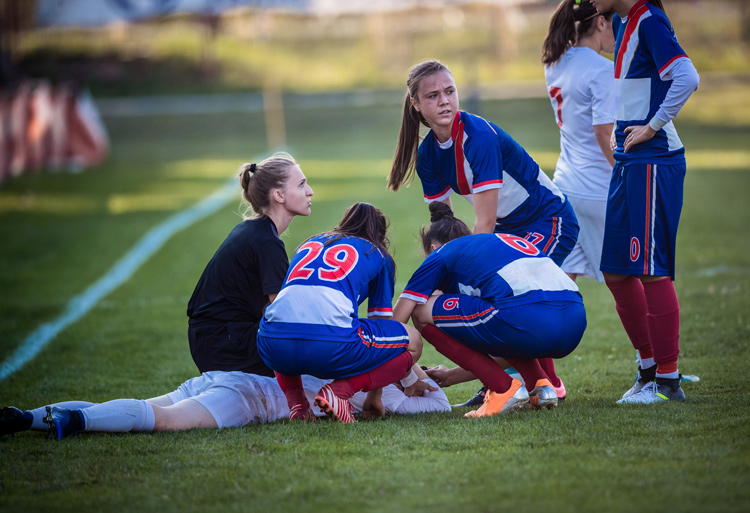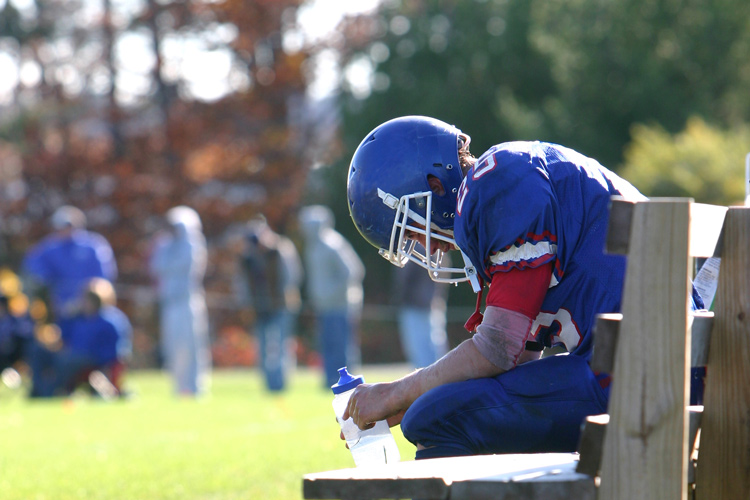Critical symptoms/signs | Obvious symptoms/signs | Subtle symptoms/signs |
|---|
- Neck pain
- Increasing confusion, agitation or irritability
- Repeated vomiting
- Seizure or convulsion
- Weakness or tingling/burning in the arms or legs
- Deteriorating conscious state
- Severe or increasing headache
- Unusual behavioural change
- Double vision
| - Loss of consciousness
- No protective action in fall to ground directly observed or on video
- Seizure or jerky movements after a knock
- Confusion, disorientation
- Memory impairment
- Unsteady on feet or balance problems
- Athlete reports significant, new or progressive concussion symptoms
- Dazed or looking blank/vacant
- Changed behaviour – may be more irritable, agitated, anxious or emotional than normal
| - Headache
- ‘Pressure in the head’
- Neck pain
- Nausea or vomiting
- Dizziness
- Blurred vision
- Balance problems
- Sensitivity to light
- Sensitivity to noise
- Feeling slowed down
- Feeling like ‘in a fog’
- ‘Don’t feel right’
- Difficulty concentrating
- Difficulty remembering
- Fatigue or low energy
- Confusion
- Drowsiness
- More emotional
- Irritability
- Sadness
- Nervous or anxious
- Trouble falling asleep (if applicable)
|
If an athlete displays these symptoms/signs they may have a more serious injury. They should be immediately taken to the nearest emergency department. |
Acute presentation
First-aid principles still apply for athletes suspected of having a concussion. Responders should systematically assess the airway, breathing, circulation, disability and exposure of the athlete in all situations.
Cervical spine injuries should be suspected if there is any loss of consciousness, neck pain or a mechanism that could lead to spinal injury. Until a cervical spine injury can be ruled out, undertake manual inline stabilisation and apply a hard collar.
In diagnosing concussion, health care practitioners should do a clinical history and examination that includes:
- mechanism of injury
- symptoms and signs
- cognitive functioning
- neurological assessment including balance testing
- a completed concussion assessment using the SCAT6 for adults or Child-SCAT6 for children aged 5 – 12 years
As part of the assessment health care practitioners may use:
- Computerised neurocognitive testing. Pre-season baseline neurocognitive testing is useful to compare against post-injury scores. Programs have reference ranges that can be applied in the absence of a baseline test.
- Medical imaging where there is suspicion of serious head or brain injury.
Currently, no serum biomarkers assist in the diagnosis of concussion. Blood tests and medical imaging is not indicated in the diagnosis or management of uncomplicated concussion.
Delayed presentation
Health care practitioners often have athletes present to the clinic during the week, having suffered a potential concussion over the previous weekend. This poses challenges. If there is any suspicion that a concussion occurred on the weekend, the health care practitioner should assume that a concussion did in fact occur. There is no test or series of tests which can conclude that a concussion did not occur.
Six key video review steps for the team clinician
Video technology is used by many professional sports to support identification of concussion, differentiate between mandatory and discretionary concussion signs and, in some instances, assist with return to sport decisions. The 2017 Berlin Concussion in Sport Group Consensus Statement identifies six steps for video-review focused on concussion identification.
Six key video-review steps for the team clinician
- Look for the suspected head impact event
- Look for the immediate response of the injured athlete (0-2 s). Does the athlete fall to the ground? If the athlete falls, is there loss of head and neck control? Does the athlete protect himself/herself when falling? If the athlete remains upright, is he/she steady on his/her feet?
- Look for the subsequent response (2-5 s). If the athlete falls, does he/she move spontaneously? Is there evidence of purposeful voluntary movement (ie, placing the ball or completing a tackle)? Is there evidence of a concussive convulsion or tonic posturing? How does the athlete respond to the attending medical staff (this phase may extend for substantially longer than 5 s, particularly if in-line cervical immobilisation is required)? If the athlete remains standing, the distinction between the subsequent and late responses may be unclear.
- Watch for the athlete’s late response when returning to his/her feet (if the athlete has fallen). Is the athlete unsteady when attempting to get to his/her feet and return to sport? Does the athlete need help from others to stand up? Are the athlete’s movements fluid and coordinated? Does the athlete fall to the ground?
- Watch the athlete’s behaviour on return to sport. Are his/her actions appropriate or not? Does he/she move immediately to the correct position on the field of play?
- Observe the responses of other athletes and match officials.


